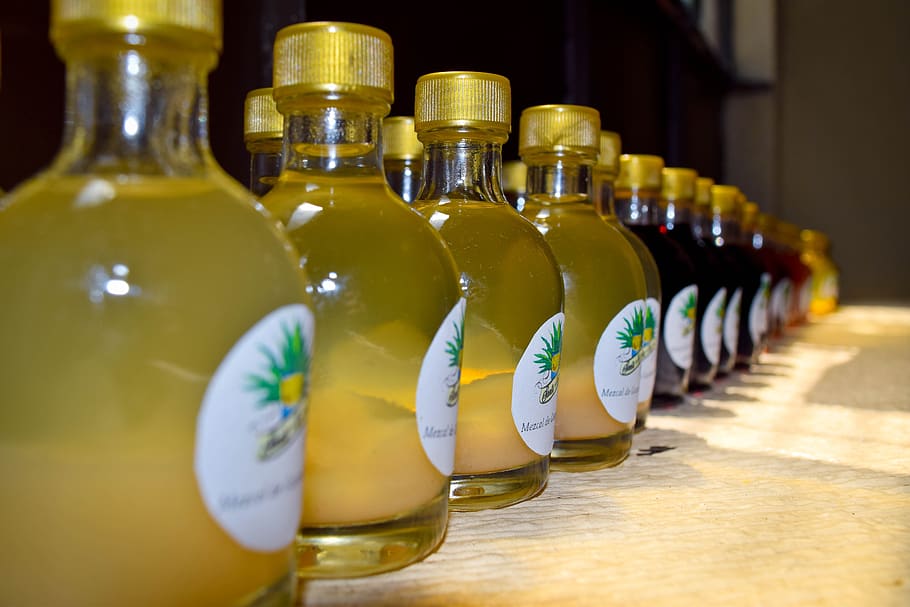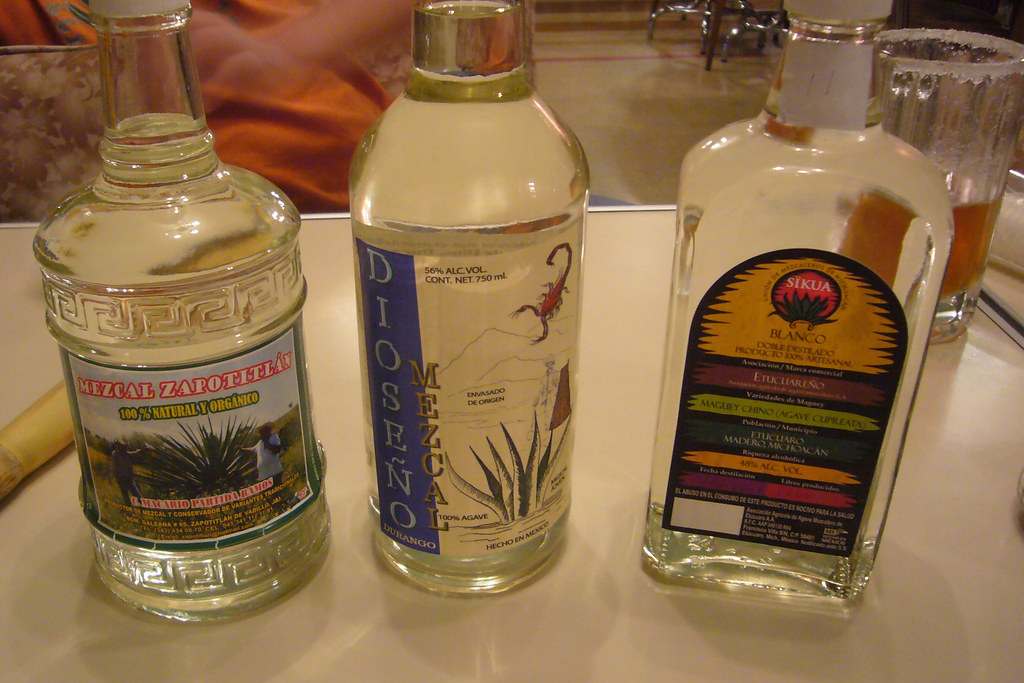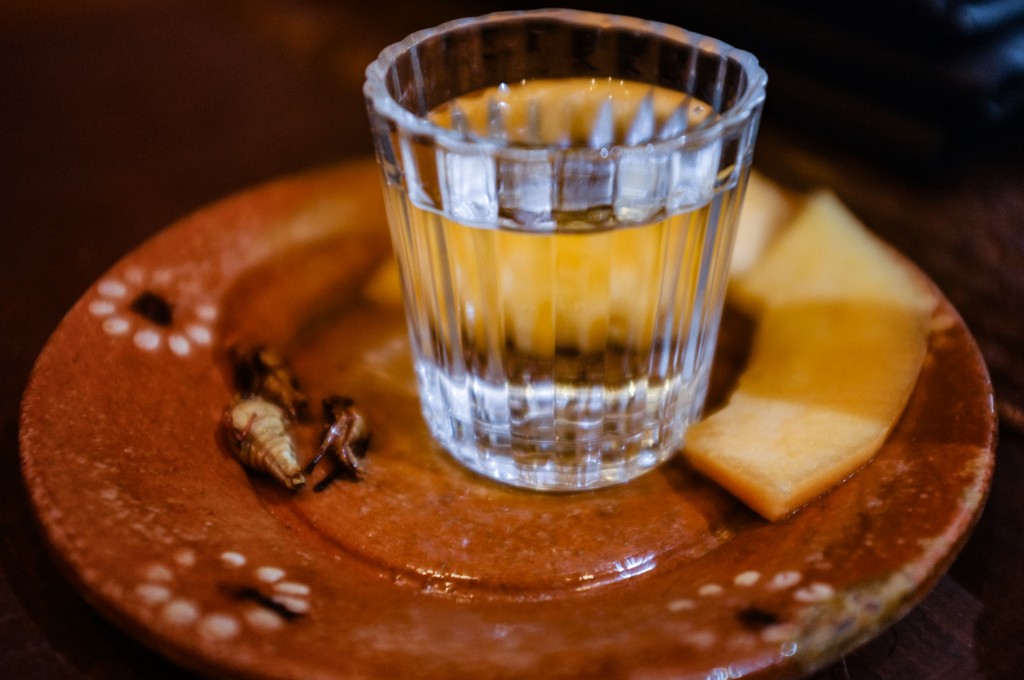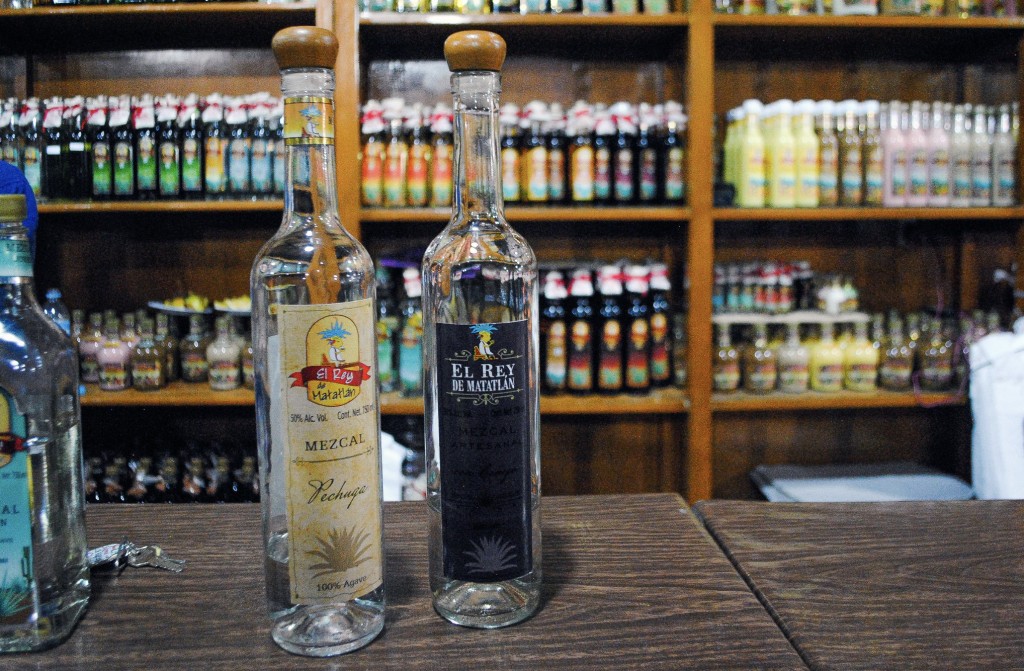
Mezcal is not your regular drink. It’s like a flavor explosion that hits all the right spots and leaves you obsessed for more. This special spirit from Mexico has become well-known and appreciated by people worldwide. But hold on, what about its taste? Let’s be honest: describing it in one sentence won’t do justice. That’s why we’re here to explore the taste of mezcal in detail and uncover what makes it unique.
What Does Mezcal Taste Like?
Mezcal has a complex and distinct taste characterized by smokiness, earthiness, and a range of vegetal, fruity, and herbal notes. It stands out for its robust and unique flavor profile, which results from multiple factors such as agave variety, production techniques, and more. Let’s take a quick look at the various flavors that define Mezcal.

Savoring the Smoky: Mezcal earns its reputation for a smoky essence due to its traditional process. Agave is roasted in underground ovens, infusing the spirit with a captivating smokiness that adds depth to its character.
Embracing the Peppery: Many Mezcals boast a peppery note, delivering a delightful spicy punch that awakens the palate. This peppery undertone lends an invigorating and memorable experience.
Connecting with the Earth: An earthy undertone is often noticed in Mezcal’s flavor. This taste is a nod to the agave plant and the nurturing soils in which it thrives, evoking a grounded and natural sensation.
Dancing with Fruits: A spectrum of Mezcals introduces fruity nuances that vary from sweet to tart. The choice of agave plays a role here, offering a medley of fruit-inspired notes that intrigue and delight.
Green and Herbal: Mezcal occasionally showcases an herbaceous quality akin to the wild herbs and plants from the agave’s habitat. This herbaceous touch creates a harmonious balance between nature and spirit.
Suggested Reading: These New Hope Eateries Will Please Your Taste Buds Like Never Before
Mezcal’s Flavor Varies Across Agave Varieties

The agave plant offers a variety of types that play a role in crafting mezcal’s distinctive flavors. While each type carries its flavors, it’s the choice you make that determines the taste of your mezcal. Here are some agave varieties that influence the flavor of this beloved spirit:
Espadin
The widely-used Espadin agave is a common choice for mezcal. It brings a mellow and sweet taste, featuring smoke, fruit, and spice hints. Espadin mezcal is a smooth and well-balanced introduction to the world of this drink.
Tobala
Tobala is a rare and wild agave that is found in high-altitude and rocky terrains. It boasts an earthy character intertwined with notes of tobacco, cocoa, vanilla, and leather. This unique blend brings together wood aromas and umami flavors, making Tobala mezcal a delicacy and a premium option.
Madrecuishe
Thriving in dry and arid regions, Madrecuishe agave represents another wild variety. It yields a fresh, herbal taste featuring notes of green pepper, mint, and grass. Madrecuishe mezcal’s crisp and lively character makes it a refreshing choice, especially on warm days.
Tepeztate
Tepeztate is an ancient and wild agave that grows on steep cliffs and rocky slopes. It takes up to 35 years to mature, resulting in a mezcal with a mineral and earthy essence complemented by notes of clay, stone, and leather. Tepeztate mezcal offers a complexity that may challenge some palates.
Arroqueno
Arroqueno thrives in fertile valleys and plains, standing tall as a giant agave. It’s a rare choice used by the Jimenez Mendez family to craft their mezcal. With a smooth beginning of bold roasted agave flavors, this velvety mezcal brings in light fruit notes and a lingering finish. Arroqueno mezcal offers richness and smoothness, fitting for any occasion.
Suggested Reading: What Does Asparagus Taste Like?
Factors That Affect the Taste of Mezcal

Variety is just one factor that affects how Mezcal tastes. Several other aspects impact the taste of Mezcal:
Age
Age of the agave plant is a key influencer in several ways. Primarily, older agave plants tend to contribute a more intricate and rich flavor to the mezcal. This occurs because they contain higher sugars and starches that develop into alcohol during fermentation and distillation.
The maturation process also exposes these agave plants to various environmental factors like soil, climate, and microorganisms. These influences combine to create unique flavor profiles that reflect the distinct characteristics of the mezcal region.
However, varying maturation periods also impact the taste of mezcal. Some agave plants take up to 25 years to fully mature and tend to produce a mezcal with a more complex and developed flavor profile. On the other hand, agave plants harvested in as little as 6 years contribute to mezcal with a comparatively lighter and simpler taste.
Fermentation
The fermentation process plays a vital role in shaping the taste of mezcal. During this complex process, the sugars in the cooked agave juice are transformed into alcohol and other compounds through the action of yeasts and bacteria. Fermentation can influence the taste because of the following aspects.
Microorganism Variety
Mezcal fermentation employs natural yeasts and bacteria found in the environment. These microorganisms can differ based on factors like location, season, agave type, and production practices. Various microorganisms produce distinct volatile compounds like alcohols, esters, acids, and more, contributing to the mezcal’s unique flavor and aroma.
Fermentation Duration and Temperature
The fermentation period varies which spans from a few days to weeks, influenced by producer preferences and conditions. Temperature also fluctuates depending on surroundings and vessel type.
The optimal temperature for fermentation is often around 77 to 86°F (25 to 30°C). These factors influence microorganism growth and activity, along with the production and evaporation of volatile compounds.
Longer fermentation periods allow more time for the yeast and other microorganisms to break down sugars and convert them into alcohol. Besides, extended fermentation can bring out fruity and floral aromas and flavors, adding complexity to the spirit. This can include notes of tropical fruits, citrus, and even floral undertones.
On the other hand, a shorter fermentation period may not allow for the full spectrum of flavor compounds to develop, leading to a more straightforward taste profile.
Shorter fermentation can mean the yeast might not have enough time to fully convert all the sugars, leading to a higher alcohol content in the final mezcal. This can result in a sharper and more pronounced alcoholic heat.
Fermentation Vessel Type
Mezcal ferments in diverse containers, such as wooden vats, clay pots, animal skins, or plastic tanks. The vessel type affects flavor and aroma by impacting oxygen availability, pH levels, heat retention, and interactions between the liquid and vessel material.
For example, Clay Pots, known as “ollas de barro” can influence the taste. Mezcal that ferments within these porous clay pots undergoes a transformation characterized by earthy undertones, mineral nuances, and a subtle herbal essence. The permeability of the clay facilitates controlled oxygen exchange, culminating in a flavor profile that reflects the vessel’s interaction with the liquid.
Additionally, the mineral composition of the clay can subtly alter the pH of the fermenting mixture, which in turn affects the behavior of yeast and other microorganisms, ultimately shaping the spirit’s taste.
With its moderate heat retention capacity, the clay pot sustains a consistent fermentation temperature, consequently influencing the pace of fermentation and the emergence of distinct earthy flavors.
Addition or Removal of Solids/Liquids
Mezcal fermentation involves filtered agave juice or juice with agave heart residues (bagasse). Some producers introduce water or other elements to adjust sugar content or enhance flavor. These additions/removals affect the fermentation mixture’s concentration, composition, and viscosity, influencing flavor and aroma.
For example, incorporating agave residues (bagasse) into the fermentation mixture can amplify the richness and complexity of the mezcal. Bagasse contains residual sugars and compounds that can contribute additional layers of flavor, including earthy and vegetal notes, while interacting with the fermenting liquid.
Besides, the introduction of water or other liquids can influence the alcohol yield and impact the overall sweetness of the mezcal. Adding liquids could dilute the mixture, potentially leading to a lighter and smoother mezcal in terms of alcohol perception and overall strength.
On the other hand, removing solids or liquids can affect the concentration of compounds in the fermentation mixture. This can influence the depth and intensity of flavors and aromas in the final mezcal.

Cooking Time
The duration of agave hearts remaining in the oven significantly impacts their flavor. If they’re cooked for a longer stretch, typically 2 to 5 days, the Mezcal gains a bolder smoky taste. This smokiness steps up a notch, making the Mezcal even more captivating.
On the flip side, a shorter cooking time for the agave hearts results in a mellower smoky flavor. This creates a Mezcal with a smoother and more varied taste profile.
The right cooking time for Mezcal can differ based on personal preferences and the type of agave used. Some folks love that strong smoky kick, while others enjoy a more subtle and diverse flavor.
Distillation Process
Distillation involves separating and purifying alcohol and other compounds from fermented agave juice. This procedure impacts mezcal’s flavor and quality in various ways:
Type and Material of the Still: Mezcal is traditionally distilled in clay or copper stills, and each material contributes distinct flavors. Clay stills can lend mezcal an earthy, rustic, and intricate taste, while copper stills yield a clean, bright, and smooth flavor. Some producers employ hybrid stills combining both materials or use alternatives like stainless steel or wood.
Number and Method of Distillations: Typically distilled twice, mezcal may undergo more or fewer distillations based on tradition and preference. Distillation frequency affects alcohol content and smoothness. More distillations generally result in higher alcohol content and milder flavor and vice versa. Yet, producers may employ diverse distillation techniques, like incorporating water or agave fibers to adjust alcohol content or enhance flavor.
Addition or Removal of Ingredients: Distillation doesn’t conclude the mezcal’s journey, as ingredients can be introduced or removed to influence the spirit’s flavor and aroma. Producers may add fruits, herbs, spices, or insects to the still, infusing unique flavors. A notable example is “mezcal de pechuga“, created by suspending raw chicken or turkey breast over the still during distillation. Some producers might filter or age mezcal in barrels to remove impurities or introduce complexity.
Handy Tip: When you’re looking at mezcal bottles, pay attention to the labels. Look for bottles with lots of information. Our experts recommend that paying attention to details such as the name of the mezcal maker, the production process, and its place of origin holds significance. The labels tell you a lot about the care that goes into making each bottle of mezcal (especially when it’s made by smaller producers).
Read Next: What Do Snails Taste Like? Do They Taste Good or Bad?
Conclusion
To truly enjoy high-quality mezcal, it’s important to deepen your understanding of it. We suggest learning about the various types of mezcal available. For an optimal tasting experience, you can explore something called the ‘kiss‘ technique.
This involves smelling the mezcal beneath your nose, then at a slight angle, and finally taking a small sip followed by a swallow. This technique helps acclimate your taste buds to the intense flavors of mezcal, allowing you to fully appreciate its diverse range of tastes.
What Does Mezcal Taste Like? - FAQs
Mezcal is a distilled alcoholic beverage originating from Mexico. It’s made from the fermented juice of the agave plant, a succulent that’s native to Mexico.
Mezcal typically has a complex flavor profile characterized by smokiness, earthiness, and a range of vegetal, fruity, and herbal notes. The intensity of smokiness can vary, and you might also taste roasted agave, citrus, tropical fruit, pepper, and even slight sweetness.
Mezcal’s smoky taste comes from the traditional production process, where agave hearts (piñas) are roasted in underground pits before fermentation. This roasting imparts smoky flavors to the agave, which are then carried through the fermentation and distillation stages.
The type of agave used significantly influences the taste of mezcal. Different agave species yield varying flavors ranging from sweet and fruity to earthy and herbal. Each agave type contributes distinct characteristics to the final product.
The diversity in mezcal flavors arises from factors like agave species, terroir, fermentation duration, and distillation methods. Fruitier mezcals might stem from agave types with sweeter profiles. The earthiness is enhanced by longer fermentation periods and specific production techniques.
![What To Wear To a Drag Show? [HOTTEST Outfit Ideas]](https://hopdes.com/wp-content/uploads/2024/01/What-to-wear-to-a-Drag-Show-390x220.jpg)



![What to Wear to an Outdoor Concert? [Cute Outfit Ideas]](https://hopdes.com/wp-content/uploads/2023/11/What-to-Wear-to-an-Outdoor-Concert-Cute-Outfit-Ideas-390x220.jpg)
